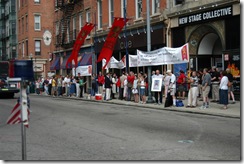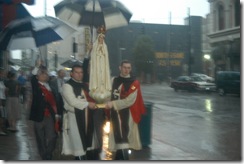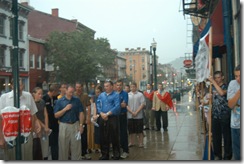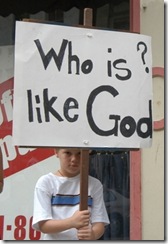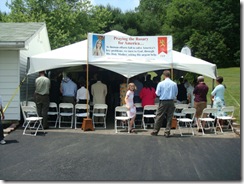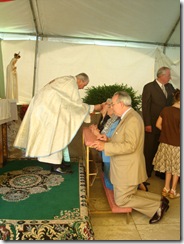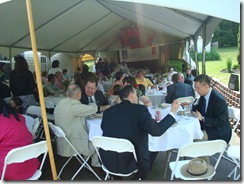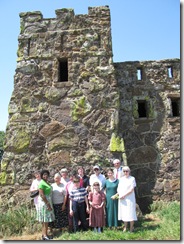Monday, June 30, 2008
More than 1,000 Captains Gearing up for October Rosary Rallies
On Saturday, June 28th, we signed up our thousandth rally captain after only two weeks of calling. During our first week we signed up 500 and then 500 more this past Saturday. We still have three and a half months to reach our goal of 3,000 rally captains.
We have been very impressed with the dedication of our volunteers. Wherever they are from, despite age, young or old, or despite health they work diligently with love for Our Lady.
A little piece of history: image of the computer screen used by the volunteer who signed up the 1,000th rally captain!
Homage to Saint Peter and His Primacy
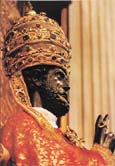 I. The Papacy: a factor of division or unity?
I. The Papacy: a factor of division or unity?
For a long time now certain theological currents and Church personalities, in the name of a heterodox interpretation of episcopal collegiality, have been proposing a change in the monarchical constitution of the Church so as to reduce the Pope’s authority to that of a mere constitutional monarch, a symbolic figurehead like the Queen of England.
As a rule, these “collegialists” seek to present the Primacy of Saint Peter as a kind of delegated power bestowed on him by the other Apostles. This would amount to introducing into the Church the egalitarian principles of the French Revolution. According to those principles, the supreme ruler of the State is nothing but a representative or delegate of the people, from whom he receives a mandate to govern in their name.
Stemming from this false premise, they draw this parallel: Just as the members of the Apostolic College would have delegated the government of the Church to Peter, their chief – a delegation that Our Lord would have ratified – so also the College of Bishops would delegate to the Pope, as head of that College, the task of governing the Church.
Indeed, the churches that sank into the Great Schism of the Orient or that were born as a result of theological dissent in the first few centuries (Monophysitism, Nestorianism, and others) reject papal Primacy and regard the Pope, at best, as a primus inter pares (“first among equals”) that is, as someone who deserves to be treated with special honors but who has no effective authority over the bishops, his peers, nor any greater decision-making power in Church government than do they.
As a result of the abandonment of the principle of unity – that is, the common submission to the Pope – those churches first fell under the dominion of the Greek Emperors, then, in part, of the Tsar of Russia and, later, the Soviet Communist Party. And, as various countries gained independence, they finally fragmented into myriads of national autocephalous churches.
Accordingly, due to the lack of a supreme point of reference – the Papacy – these churches become increasingly torn apart by all kinds of theological differences and disagreements over liturgical and disciplinary matters. Although some of their dignitaries carry imposing titles – Patriarch, Katholikos, Metropolitan, and others – their authority over other hierarchs and members of these churches is almost nonexistent.
The same occurred with the religious communities arising from the Protestant revolt against the Papacy and their metastases over centuries. The autonomy of each congregation within the same denomination is such as to leave no room for a central power to impose rules on the whole or to speak in the name of all members.
History has shown that if the Papacy is a rock of scandal and a factor of division for all dissidents, it is also the principle of unity for the faithful of the true Church of Christ, built upon the rock of Peter.
Today’s collegialist current seeks the basis for its doctrine in the Dogmatic Constitution Lumen Gentium, of Vatican Council II. Now then, the doctrine on episcopal collegiality contained in that document must be understood according to the “Prefatory Note of Explanation” published by order of the Pope as a norm for interpreting that document.[1] The Note reads:
“College is not understood in a strictly juridical sense, namely, of a group of equals who entrust their power to their president, but of a stable group whose structure and authority is to be deduced from revelation.…
“The parallel between Peter and the other apostles on the one hand, and the Supreme Pontiff and the bishops on the other, does not imply any transmission of the extraordinary power of the apostles to their successors, nor, as is clear, any equality between the head and the members of the College….”[2]
This clearly states the legitimate meaning of the term collegiality, in that the Pope is not the mere president of a college of equals. He is the chief and head of a college from which he stands out by the power and authority he exerts upon all its other members and upon the whole Church. It also makes clear that the bishops, successors of the Apostles, did not receive from the latter the extraordinary powers that they enjoyed.
II. The Apostolic College and the College of Bishops
As a group, the Apostles are considered founders of the Church, though not in the same way as Saint Peter. They all were given the power to bind and to loosen and were entrusted with the mandate of preaching to all peoples:
“All power is given to Me in heaven and in earth. Going therefore, teach ye all nations; baptizing them in the name of the Father, and of the Son, and of the Holy Ghost; teaching them to observe all things whatsoever I have commanded you: and behold I am with you all days, even to the consummation of the world” (Matt. 28:18-20).
Our Lord makes them, as a group, His continuators, grants them His own power to govern and sanctify the faithful, and promises to remain with them until the end of time. This is tantamount to saying that through preaching and the Sacraments they were to found a religious society that would live on after their deaths in the persons of their successors.
This religious society they founded is the Church, governed by Peter and his successors (Matt. 16:18-19; 18:18-19).
Nevertheless, a clarification and an important distinction should be made here. The Apostles received from the Savior two different powers, albeit inseparable from their persons: a) apostolic power – personal and non-transferable powers and privileges, granted to them as witnesses of the Resurrection and founders of the Church, that were necessary for carrying out their apostolic mission of establishing Christ’s Church; b) episcopal power – necessary powers for their pastoral mission of teaching, governing, and sanctifying the Church. The bishops are the successors and continuators of the Apostles only insofar as the Episcopal power is concerned. They are not such regarding the apostolic power since they are neither witnesses of the Resurrection nor founders of the Church. Hence they did not receive the apostolic, personal, and non-transferable privileges properly speaking, which are:
Confirmation in grace – The Apostles received so abundant an infusion of grace, especially at Pentecost, that they could avoid every mortal fault and every fully deliberate venial sin.
Universality of jurisdiction – The Apostles, having had the mandate of constituting by conquest the kingdom of God in the world, had no territorial limitations. This function of conquest, being directed to the organization of the ecclesiastical society, was of its nature transient (a personal prerogative).
Personal infallibility – The Apostles enjoyed this privilege in matters of faith and morals, but only when they taught and imposed some doctrine as obligatory.
Prophetism – The Apostles were also prophets, that is to say, persons in immediate contact with God and receiving directly from Him the truth they were to transmit to the Church in His Name. Upon the death of the last Apostle, Saint John, the official Revelation of the Church was definitively closed and the apostolic mission ended.[3]
The Bishops are successors of the Apostles in their Episcopal task of shepherds, teachers, and sanctifiers. They do not, however, enjoy confirmation in grace, universal jurisdiction, personal infallibility, or apostolic prophetism in the sense defined above. The Pope himself, though infallible according to the terms defined by the First Vatican Council (that is, in matters of faith and morals, when he teaches a truth to the whole Church in a definitive manner), does not enjoy the personal prerogative of confirmation in grace nor that of being a source of Revelation. As that Council calls to mind, the Petrine privilege (that is, papal infallibility) was instituted not to teach new doctrines not contained in Revelation but only to define and make explicit the doctrines already contained in the deposit of Revelation.[4]
III. The Primacy of Saint Peter, a reward for his profession of Faith
To make it easier to understand the traditional doctrine of the Church, it is well to call to mind the texts of Scripture that refer to the institution of the papal Primacy, as well as the commentaries of Church Doctors on this subject.[5]
There are two Gospel texts directly pertaining to the establishment of the Papacy: Matthew 16:13-19 and John 21:15-17.
Let us start with Saint Matthew:
"And Jesus came into the quarters of Cesarea Philippi: and he asked His disciples, saying: Whom do men say that the Son of man is?
But they said: Some John the Baptist, and others Elias, and others Jeremias, or one of the prophets.
Jesus saith to them: But whom do you say that I am?
Simon Peter answered and said: Thou art Christ, the Son of the living God.
And Jesus answering said to him: Blessed art thou, Simon Bar-Jona: because flesh and blood hath not revealed it to thee, but my Father who is in heaven.
And I say to thee: That thou art Peter; and upon this rock I will build My Church, and the gates of hell shall not prevail against it.
And I will give to thee the keys of the kingdom of heaven. And whatsoever thou shalt bind upon earth, it shall be bound also in heaven: and whatsoever thou shalt loose on earth, it shall be loosed also in heaven.” (Matt. 16:13-19).
Commenting on this text, Saint Jerome underlines the direct relationship between Saint Peter’s proclamation of faith and the honor Our Lord gave him for it. The parallel drawn between the affirmation of Peter and the Savior’s response is perfect:
“Thou art Christ the Son of the living God,” Saint Peter proclaims.
“Thou art Peter; and upon this rock I will build My Church,” Our Lord responds.
This comparison makes it very clear that the immediate reason for Saint Peter’s being made Pope was his profession of Faith in the divinity of Christ. The moment Saint Peter recognized Christ as God, Jesus promised him the Papacy.
It is true that Saint Peter spoke as an Apostle, since Our Lord, after asking what the people were saying of Him, directly asked the Apostles as a whole: “But whom do you say that I am?” Taking the lead, Peter spoke in their name but not by their delegation or inspiration, but rather by divine choice and inspiration.
In promising him the Papacy, Our Lord explains why by emphasizing that Peter spoke by divine inspiration: “Blessed art thou, Simon Bar-Jona: because flesh and blood hath not revealed it to thee, but my Father who is in heaven.”
Cornelius a Lapide comments:
“Peter, as about to be constituted after the resurrection the Prince of the Apostles and of the whole Church, being more deeply taught and inspired by God, recognized the Divinity of Christ, and answered concerning it what all the rest would have answered. This is plain because to Peter only, as the reward of this confession, Christ promised the most ample reward and prerogative. For He says to him by name above the rest of the Apostles, ‘Blessed art thou, Simon Bar-Jona.’”[6]
Therefore the elevation of Saint Peter to the Papacy depended not on a choice or delegation of the Apostolic College but exclusively on the will of God, Who revealed directly to him the divinity of Christ and impelled him to make the proclamation that earned him such an unparalleled promise.
IV. As He changed Saint Peter’s name, Jesus bestowed on him his mission as Head of the Church
The fact that Our Lord changed the name Simon to Peter emphasizes the personal character of His choice.
“Jesus imposed on Simon the name Peter (Matt. 10:2; Mark 3:16; Luke 6:14; John 1:42). According to biblical custom, a change of name had great significance: When God wished to establish the patriarchate, He chose Abram to be head and center of that institution and changed his name to Abraham; when He instituted the Synagogue He chose as its head another great patriarch, Jacob, and changed his name to Israel. The mysterious meaning of the new name [Simon] was revealed by the Master in the memorable scene that took place at the foot of Mount Hermon: ‘…thou art Peter and upon this rock I will build my church.’”[7]
The first change of Simon’s name took place when his brother, Saint Andrew, took him to meet the Messias: “And Jesus looking upon him, said: Thou art Simon the son of Jona. Thou shalt be called Cephas, which is interpreted Peter” (John 1:42).
Later, the Savior used roughly the same words to promise him the Primacy: “Simon Bar-Jona…thou art Peter and upon this rock I will build my Church” (Matt 16:17-18).
V. The Church, the new Sion, founded upon the rock of Peter
The words of Our Lord in relation to Peter call to mind the prophecy of Isaias: “Therefore thus saith the Lord God: Behold I will lay a stone in the foundation of Sion, a tried stone, a corner stone, a precious stone, founded in the foundation.” (Is. 28:16).
The new Sion is the Church, the house of God, whose cornerstone is Christ (Matt. 21:42; 7:24-25; 1Pet. 2:7; 1Cor. 3:9,11; 1Tim. 3:15; Ps. 118:22).
If Christ, the cornerstone of the Church, designates Saint Peter as the stone upon which his Church is built, this means that the Head of the Apostles is almost another Christ and is His Vicar, the one acting for and in the place of Christ. Our Lord gives Saint Peter his own powers so that he may be able to govern the Church:
“And I will give to thee the keys of the kingdom of heaven. And whatsoever thou shalt bind upon earth, it shall be bound also in heaven: and whatsoever thou shalt loose on earth, it shall be loosed also in heaven.”
Again the Savior refers to a prophecy of Isaias related to Eliacim, a minister of Ezechias, whom the Fathers of the Church consider a prefigure of the Messias: “And I will lay the key of the house of David upon his shoulder: and he shall open, and none shall shut: and he shall shut and none shall open” (Is 22:22).
To give Saint Peter the keys to the Kingdom of Heaven and the power to bind and loosen on earth and in Heaven is to grant him the undivided government of the Church, a society at the same time supernatural (the life of grace) and natural (the human element), the two elements being represented by Heaven and earth.
VI. Our Lord bestows the Primacy on Saint Peter
The Primacy of Peter, which was indirectly suggested with the name change of the Apostle in the beginning of his apostolate and later promised in the dialogue at Cesarea, was officially bestowed upon him by Our Lord after the Resurrection and shortly before the Ascension.
Saint John describes the scene:
When therefore they had dined, Jesus saith to Simon Peter: Simon, son of John, lovest thou me more than these? He saith to him: Yea, Lord, thou knowest that I love thee. He saith to him: Feed my lambs.
He saith to him again: Simon, son of John, lovest thou me? He saith to him: Yea, Lord, thou knowest that I love thee. He saith to him: Feed my lambs.
He said to him the third time: Simon, son of John, lovest thou me? Peter was grieved, because he had said to him the third time: Lovest thou me? And he said to him: Lord, thou knowest all things: thou knowest that I love thee. He said to him: Feed my sheep (John 21:15-17).
Again Our Lord grants Saint Peter His own attributes, since He is the Supreme Shepherd, the Good Shepherd who gives His life for His sheep (John 10:11), feeds and protects them from danger and goes after those who have strayed (Luke 1:7). By entrusting Peter with the task of governing and feeding his sheep, Our Lord makes him His substitute or vicar with the fold.
Cornelius a Lapide comments:
“When Christ was about to go away into heaven, He here appoints Peter His vicar upon earth, and creates him Chief Pontiff, that the one Church might be ruled by one shepherd. Christ had promised the same thing to Peter (Matt. 16:18), but in this place He confers the gift, and constitutes him prince and ruler of the whole Church, lest any one, on account of Peter’s threefold denial, should say that Christ had changed His decrees concerning him.”[8]
The scholarly Jesuit explains:
“[T]o feed in Scripture signifies to rule, and kings are called shepherds, because if they would rightly rule their subjects, they ought to do what shepherds do when they feed their sheep. …Thus Cyrus is called a shepherd, i.e., a prince and king appointed by God” (Is. 44:28).[9]
But, Saint John Chrysostom asks:
“Why does He pass over the others and speak of the sheep to Peter? He was the chosen one of the Apostles, the mouth of the disciples, the head of the choir. For this reason Paul went up to see him rather than the others. And also to show him that he must have confidence now that his denial had been purged away. He entrusts him with the rule over the brethren.... If anyone should say ‘Why then was it James who received the See of Jerusalem?’ I should reply that He made Peter the teacher not of that see but of the whole world.”[10]
According to some commentators, the triple question of Our Lord – “Peter, lovest thou me?” – was intended to draw from him the threefold profession of love and thus make reparation for his three denials during the Passion.
Since the Church must last “even to the consummation of the world” (Matt. 28:20), Our Lord’s promises to Peter must dwell in his successors, the Popes.
With a solid foundation in Scripture and Tradition, this doctrine was solemnly defined by the extraordinary magisterium of the Church during the First Vatican Council.
VII. The doctrine of the First Vatican Council
In the first chapter of the Dogmatic Constitution Pastor Aeternus, the First Vatican Council (1869-1870) defined in a clear and unassailable manner the effective primacy, not only of honor but also of jurisdiction, that was bestowed upon Peter and his successors, the Popes, over the other Apostles and their successors, the Bishops. Thus reads this infallible document of the extraordinary magisterium:
So we teach and declare that according to the testimonies of the Gospel, the primacy of jurisdiction over the entire Church of God was promised and was conferred immediately and directly upon the blessed apostle Peter by Christ the Lord. For the one Simon, to whom he had before said: “Thou shalt be called Cephas (John 1: 42), after he had given forth his confession with those words: “Thou art Christ, Son of the Living God (Matt 16:16), the Lord spoke with these solemn words: “Blessed art thou, Simon Bar-Jona; because flesh and blood hath not revealed it to thee, but my Father who is in heaven. And I say to thee: That thou art Peter, and upon this rock I will build my Church, and the gates of hell shall not prevail against it: and I shall give to thee the keys of the kingdom of heaven. And whatsoever thou shalt bind upon earth, it shall be bound also in heaven: and whatsoever thou shalt loose upon earth, it shall be loosed also in heaven (Matt. 16:17ff).
And upon Simon Peter alone Jesus after His resurrection conferred the jurisdiction of the highest pastor and rector of his entire fold, saying: “Feed my lambs,” “feed my sheep” (John 21:15ff).
To this teaching of Sacred Scriptures, so manifest as it has been always understood by the Catholic Church, are opposed openly the vicious opinions of those who perversely deny that the form of government in His church was established by Christ the Lord; that to Peter alone, before the other apostles, whether individually or all together, was confided the true and proper primacy of jurisdiction by Christ; or, of those who affirm that the same primacy was not immediately and directly bestowed on the blessed Peter himself, but upon the Church, and through this Church upon him as the minister of the Church herself.” (Denzinger, no. 1822).
There follows the anathema[11] against those who deny this doctrine:
If anyone then says that the blessed Apostle Peter was not established by the Lord Christ as the chief of all the Apostles, and the visible head of the whole militant Church, or, that the same received great honor but did not receive from the same Our Lord Jesus Christ directly and immediately the primacy in true and proper jurisdiction: let him be anathema.” (Denzinger, no. 1823).
The First Vatican Council, in Chapter II of the same infallible Constitution Pastor Aeternus, insists on the permanence of this Primacy of Peter in the Roman Pontiffs throughout time even to the consummation of the world:
Moreover, what the Chief of pastors and the Great Pastor of sheep, the Lord Jesus, established in the blessed Apostle Peter, for the perpetual salvation and perennial good of the Church, this by the same Author, must endure always in the Church which was founded upon a rock and will endure firm until the end of the ages. Surely, “no one has doubt that all ages have known that the holy and most blessed Peter, chief and head of the apostles and pillar of faith and foundation of the Catholic Church, received the keys of the kingdom from Our Lord Jesus Christ, the Savior and Redeemer of the human race; and he up to this time and always lives and presides and exercises judgment in his successors, the bishops of the holy see of Rome, which was founded by him and consecrated by his blood (cf. Council of Ephesus, no. 112).
Therefore, whoever succeeds Peter in this chair, he according to the institution of Christ himself, holds the primacy of Peter over the whole Church. “Therefore, the disposition of truth remains, and blessed Peter persevering in the accepted fortitude of the rock, does not abandon the guidance of the Church which he has received” [Leo I, Sermon 3 (elsewhere 2), C. 3 PL 54, 146]. For this reason, it has always been necessary for mightier preeminence for every church to come to the church of Rome, that is those who are the faithful everywhere” [St. Irenaeus, Adv. haereses I. 3, c. 3, MG 7, 849A] so that in this see, from which the laws of “venerable communion” [St. Ambrose ep. no. 4, ML 16, 946A] emanate over all they as members associated in one head, coalesce into one bodily structure. (Denzinger, no. 1824).
It also finishes with an anathema against the foolhardy who dare disagree with this doctrine:
If anyone then says that it is not from the institution of Christ the Lord Himself, or by divine right that the blessed Peter has perpetual successors in the primacy over the universal Church, or that the Roman pontiff is not the successor of blessed Peter in the same primacy, let him be anathema. (Denzinger, no. 1825).
Conclusion
By divine will the Church is a monarchy[12] in which the Pope governs effectively, uniting in his hands, on a universal scale, the supreme legislative, executive, and judiciary powers, in addition to the supreme magisterium.
This truth, taught from the very beginnings of the Church, is infallibly reiterated by the Dogmatic Constitution Pastor Aeternus, of the First Vatican Council, which ends with a threat of anathema, that is, excommunication, for those who deny this doctrine. The same Council defined, in an infallible way, that the primacy of Peter continues in his successors, the Popes.
The papal primacy – not only honorific but also a real, direct, and immediate primacy of the Roman Pontiff upon the whole Church – is so by Divine right. Our Lord Jesus Christ directly instituted it and no power on earth can either abolish or weaken it.
__________________
Footnotes:
 “From a higher authority [footnote: “…‘higher authority’ (presumably Pope Paul himself)…”] there is communicated to the Fathers an explanatory and prefatory note on the modi concerning Chapter III of the schema De Ecclesia [Lumen Gentium]. The doctrine set forth in this same Chapter III ought to be interpreted and understood according to the mind and opinion of this note” Walter M. Abbot, S.J., General Editor, The Documents of Vatican II, (New York: The America Press, 1966), p. 98 and n. 3.
“From a higher authority [footnote: “…‘higher authority’ (presumably Pope Paul himself)…”] there is communicated to the Fathers an explanatory and prefatory note on the modi concerning Chapter III of the schema De Ecclesia [Lumen Gentium]. The doctrine set forth in this same Chapter III ought to be interpreted and understood according to the mind and opinion of this note” Walter M. Abbot, S.J., General Editor, The Documents of Vatican II, (New York: The America Press, 1966), p. 98 and n. 3. Ibid., pp. 98-99.
Ibid., pp. 98-99. Cf. Honoré Coppieters, “Apostles,” The Catholic Encyclopedia (New York: Encyclopedia Press, Inc., 1913), Vol. I; J. Bainvel, “Apôtres,” Dictionnaire de Theologie Catholique (Paris: Librairie Letouzey et Ané, 1931), Vol. I, 2nd part; Pietro Parente, Antonio Piolante, Salvatore Garofalo, “Bishops,” Dictionary of Dogmatic Theology (Milwaukee: Bruce Publishing Co., 1951).
Cf. Honoré Coppieters, “Apostles,” The Catholic Encyclopedia (New York: Encyclopedia Press, Inc., 1913), Vol. I; J. Bainvel, “Apôtres,” Dictionnaire de Theologie Catholique (Paris: Librairie Letouzey et Ané, 1931), Vol. I, 2nd part; Pietro Parente, Antonio Piolante, Salvatore Garofalo, “Bishops,” Dictionary of Dogmatic Theology (Milwaukee: Bruce Publishing Co., 1951). “For, the Holy Spirit was not promised to the successors of Peter that by His revelation they might disclose new doctrine, but that by His help they might guard sacredly the revelation transmitted through the apostles and the deposit of faith, and might faithfully set it forth” (Pastor Aeternus, Chap. IV, Denzinger, no. 1836 [translated by Roy J. Deferrari]).
“For, the Holy Spirit was not promised to the successors of Peter that by His revelation they might disclose new doctrine, but that by His help they might guard sacredly the revelation transmitted through the apostles and the deposit of faith, and might faithfully set it forth” (Pastor Aeternus, Chap. IV, Denzinger, no. 1836 [translated by Roy J. Deferrari]). See Thomas W. Mossman, Transl., The Great Commentary of Cornelius a Lapide (London: John Hodges, 1893).
See Thomas W. Mossman, Transl., The Great Commentary of Cornelius a Lapide (London: John Hodges, 1893). The Great Commentary of Cornelius a Lapide, St. Matthew’s Gospel, p. 210.
The Great Commentary of Cornelius a Lapide, St. Matthew’s Gospel, p. 210. “Primacy of St. Peter,” Dictionary of Dogmatic Theology, pp. 228-229.
“Primacy of St. Peter,” Dictionary of Dogmatic Theology, pp. 228-229. The Great Commentary, St. John’s Gospel, p. 295.
The Great Commentary, St. John’s Gospel, p. 295. Ibid., p. 297.
Ibid., p. 297. In G. H. Joyce, “The Pope,” The Catholic Encyclopedia, Vol. XII, pp. 261-262.
In G. H. Joyce, “The Pope,” The Catholic Encyclopedia, Vol. XII, pp. 261-262. “Anathema, in actual Church discipline, is the term also used for ipso facto excommunication incurred by those denying a solemnly defined truth, as is concluded principally from the dogmatic canons of the Council of Trent and the [First] Vatican Council: ‘If anyone denies [this truth] …let him be anathema’, i.e., excommunicated” (Dictionary of Dogmatic Theology. p. 10).
“Anathema, in actual Church discipline, is the term also used for ipso facto excommunication incurred by those denying a solemnly defined truth, as is concluded principally from the dogmatic canons of the Council of Trent and the [First] Vatican Council: ‘If anyone denies [this truth] …let him be anathema’, i.e., excommunicated” (Dictionary of Dogmatic Theology. p. 10). One need not shudder at the mention of monarchy. As applied to the government of the Church, monarchy has none of the pejorative connotations added to it in temporal society during the period of the “enlightened despots” of the seventeenth and eighteenth centuries.
One need not shudder at the mention of monarchy. As applied to the government of the Church, monarchy has none of the pejorative connotations added to it in temporal society during the period of the “enlightened despots” of the seventeenth and eighteenth centuries.
State-Mandated Education
The Vancouver Board of Education mandated that parents cannot pull their children out of classes teaching homosexuality.
For the full story, GO HERE:
http://www.canada.com/vancouversun/story.html?id=6254da86-1d4d-4fc4-aafb-e055502cd2a8
Sunday, June 29, 2008
Are Protests Against Blasphemy Effective? The Other Side Speaks
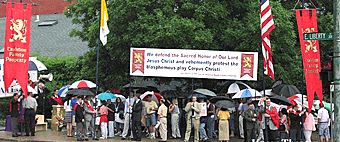
“Accept that you are not going to win. There is no win in such a controversy. You're just going to survive. Those are the facts. It's not pretty, but those are the facts.” [1] ![]()
Such was the counsel of journalist Hollis Walker to museum directors and curators regarding protests against blasphemous art. Her comments run quite contrary to what protesters are frequently led to believe.
Indeed, Catholics who protest blasphemy are often told that they are ineffective since the offending piece is rarely removed.
At best, they are told, their anti-blasphemy efforts are but symbolic gestures. Others dismiss all protesting as free publicity for the offending work.
The arts establishment pretends not to notice protesters and makes it seem that the protesters’ efforts are of no avail.
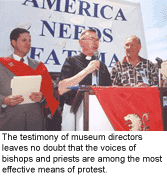
Rarely does the protester see what actually happens on the other side of the museum doors when blasphemy is displayed. Piercing the silence, however, can be quite revealing.
Piercing the Silence
The American Association of Museums (AAM) held its 96th Annual Meeting in Dallas on May 12-16, 2002, at the Dallas Convention Center. More than 5,000 museum professionals representing approximately 1,000 museums from every state and 30 foreign countries convened in what was termed “the largest cultural gathering in the world.”
This august forum was the scene of a panel discussion that shows just how seriously the arts establishment takes anti-blasphemy protesters.
“I felt I was at a secret meeting of the opposition,” said TFP observer James Miller, who attended the event. “I couldn’t believe how they just said everything. It was like being on the other side of the museum door during the protest.”
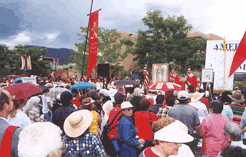
Panelist John McCarthy told the audience that only 300 appeared at the TFP rally. However, TFP members collected over 600 signatures.
Even more revealing was the fact that the panel focused on the controversy surrounding a blasphemous portrayal of Our Lady of Guadalupe in Santa Fe, New Mexico, in February of 2001. The American Society for the Defense of Tradition, Family and Property (TFP) and its America Needs Fatima campaign worked together with local activists to protest the portrayal. The rally gathered nearly a thousand Catholics.
“Our Lady of Controversy”

The true image of Our Lady of Guadalupe.
“Our Lady of Controversy: The Cyber Arte Exhibition at the Museum of International Folk Art” was the very suggestive title of the panel discussion. Various experts from the museum field were selected to speak to the audience on how to deal with protests against blasphemy.
As the title suggests, the panel’s purpose was to discuss the controversy that surrounded Alma Lopez’s “Our Lady” at Santa Fe’s Museum of International Folk Art. Press reports described the exhibit as a computer collage portraying a bikini-clad Virgin of Guadalupe held aloft by a topless female angel.
For months, this “artwork” divided the community. The June 30 rally in front of the museum united offended Catholics from all over New Mexico and at least seven other states. The America Needs Fatima campaign mobilized tens of thousands nationwide to send “Enough is enough!” protest postcards. The TFP website asked supporters to send instant e-mail protests. The effort received letters of support from bishops, priests, and national conservative figures, including congressmen.
“Completely Vulnerable”
The panel speakers stressed that controversy is extremely upsetting and outlined some tactics for dealing with the problem. Above all, it became very clear that they do not view protests as free publicity.
“I was amazed to hear them confess how utterly vulnerable they felt,” reported Mr. Miller. “They really take protests seriously.”
Indeed, the panel moderator complained that museums are naïve about their work and totally unprepared to deal with such controversies. Panelists reported their own helplessness in explaining to the public their reasons for airing blasphemy. They noted how one scene of a protester praying a rosary on the evening news had the effect of erasing any sympathy for the museum from the viewing public.
They were especially exasperated by the fact that the museum was constantly on the defensive and could never break out of the media siege.
How Effective Protests Are
Ironically, all the myths about blasphemy protests were destroyed by the very people who display such works. They testified that protests are not just symbolic gestures or free publicity but effective statements that echo throughout the arts community.
Alma Lopez, creator of “Our Lady,” speaking on the panel, admitted that it was “difficult and hard to go through all this.” She received hundreds and hundreds of e-mails per day from offended Catholics and even from children. The controversy surrounding her unpopular work left her perplexed and “marginalized.” “People are really paying attention to them,” she complained, “and our voices are not being heard at all.”
“The press with the twenty-second sound byte just kills you,” commented John McCarthy, deputy director of the Folk Art Museum. “There is no way you can present your story.”
Because of the work of a few dedicated protesters, everyone from the governor’s office to the museum regents were suddenly concerned. The controversy became national and even international news.
Uncompromising Protest
Panel speakers were also impressed by the organization of the protesters. They presented slides and video clips to illustrate the point.
They were surprised by the fact that the protesters were “more coordinated” than they were. Everywhere they turned they met opposition and “organized loud protest.”
Deputy Director McCarthy showed the national projection of the controversy by admitting that the museum received over 65,000 “Enough is enough!” protest postcards from the TFP effort. They were still coming months after the exhibit came down.
The museum directors had hoped to diffuse the controversy by entering into dialogue and compromise with protesters. The unbending attitude of the protesters left them empty-handed.
In fact, it was the directors who eventually made concessions. They canceled the four-month extension they had planned for the exhibit, closing it on the originally scheduled date. Even so, the protesters were still not satisfied.
“How serious do you take these people?” Mr. McCarthy asked, then answered himself: “Very serious!” He further noted that the museum was always unprepared, especially since the protesters “never, never gave in on any point.”
It is important to note as well that the panelists acknowledged how important it is for the local bishop to speak out against blasphemy. The fact that Archbishop Michael Sheehan of the Santa Fe Archdiocese condemned the work at the beginning of the showing caused irreparable damage to the museum public relations campaign.
“If only bishops and priests realized just how effective their protest could be!” commented Mr. Miller after the session. He observed how panelists qualified the Archbishop of Santa Fe as one of the “most powerful people in the state of New Mexico.” His condemnation was hardly free publicity.
Journalist and panel member Hollis Walker bluntly told the audience that blasphemy protests are no-win situations for museums. Their best policy is defense and damage control.
“At the very beginning, if you see something like this erupting, my best advice to you is to go hire the best public relations crisis consultant you can find,” she stressed, “because the internal public relations and marketing people at museums are not equipped to deal with this kind of issue.” ![]()
Long-term Consequences
The consequence of a blasphemy protest goes beyond the time the exhibit is displayed. Controversy sends shock waves throughout the arts community. The ugliness of blasphemy is such that people tend to disassociate themselves from it when it is exposed.
Dr. Joyce Ice, director of the Folk Art Museum’s Office of Cultural Affairs, told the audience how controversy affects the judgment of museum directors. She pointed out “that the danger now lies not so much in being silenced but to censor ourselves in the future.”
Journalist Hollis noted that the large art community in Santa Fe remained silent during the controversy. While Catholics united and proudly stood behind Our Lady of Guadalupe, the local arts establishment did very little to come to the aid of their fellow artist.
Museum Director Tom Wilson pointed out that the controversy created a rift with the local community. Months after the exhibit came down, the wounds were still open. “We have not completely finished the healing process, or maybe in some ways you can say we haven’t really begun it,” he said.
Nearly a year after the whole controversy, the reverberations of the protest still linger. One of the questions posed to gubernatorial candidates this fall was how they would have handled the “Our Lady of Guadalupe controversy.”
Even the long-term future of the exhibit itself was affected by the protests. When asked by TFP observer James Miller about the future of the exhibit, panelists did not know, although they assured the audience that it presently had a home in the Museum of International Folk Art – safely stored in the basement.
Why Protests Are Necessary
Perhaps one of the most influential panelists was Jim Fitzpatrick, a lawyer from the Washington, D.C., firm of Arnold & Porter. Mr. Fitzpatrick has defended many offensive art pieces in what has come to be known as the “cultural wars.” He also outlined the chilling perspective of what museum will try to show in the future.
Make no mistake about it, the issue is more than just art. Mr. Fitzpatrick correctly classified the controversy surrounding these exhibits as religious, political, and ideological clashes. From the very beginning, the flashpoint of cultural wars has been art-termed-blasphemy and it will continue to be so in the future.
Mr. Fitzpatrick called upon the arts establishment not to cave in to protesters who oppose what they consider blasphemous portrayals. Rather, it must redouble its efforts and present things that challenge or even violate society standards.
“The standard of universal decency and acceptability in a society like ours,” he claimed, “is simply meaningless.”
Moreover, Mr. Fitzpatrick outlined the areas of “art” where the museum community must defend itself.
There are three areas where I think museums are going to be subject to attack: Images of gay sex will be a problem because society has still not broadly accepted that way of life. Second, “kiddy porn” portrayals of young children in sexual situations will continue to be highly controversial and this is one area where the courts have given more elbow room to legislators and officials to limit creativity….
“It’s clear,” Mr. Fitzpatrick continued, “that allegedly blasphemous works of visual art are going to be of continuing concern.” ![]()
The statements of Mr. Fitzpatrick and other panelists make clear why protests are so very necessary. Without them, the arts community has a virtual blank check to push back the standards of decency and morality that still remain in society.
A How-to Manual in Reverse
“Our Lady of Controversy: The Cyber Arte Exhibition at the Museum of International Folk Art” panel discussion was an important look “behind the doors” of the arts community.
By outlining their tactics against protesters, the panelists inadvertently provided a veritable how-to manual in reverse that can help protesters design a more effective protest.
Indeed, there are several lessons to be learned. First, listening to the other side should destroy the myth that all protest is useless. Quite the contrary, protest is the only effective means of defending the Faith and Catholic morality in face of ever-more-horrific attacks. Protesters must be convinced that blasphemous portrayals can be no-win situations for museums.
Second, museums and theaters are ill equipped to deal with well-organized protests. Protesters must be “wise as serpents and simple as doves” (Matt. 10:16) and develop peaceful protests that reflect a will never to give in. They must resist the efforts of museum directors who would lead them to compromise their principles through dialog in hopes of defusing the controversy. Uncompromising protests serve to underscore the ugliness of blasphemy and enlist the sympathy of the public.
Third, clergy should be encouraged to add their voices to this struggle. The testimony of museum directors leaves no doubt that the voices of bishops and priests are among the most effective means of protest.
Fourth, since blasphemous art is the flashpoint of the culture wars, protesters must redouble their efforts and continue to stand tall in the face of adversity. Protesters are an important line of defense in keeping out a new wave of other portrayals (such as “kiddie porn”) that will erode public morality yet further.
Finally, Catholics protesting blasphemy do more than just preserve public morality. By protesting, they defend the honor of God and Our Lady. This task is a right, a duty, and a privilege. Even if protests were less effective, this defense alone would justify all the effort. Continuing in this struggle, protesters can be assured that God and the Blessed Mother will bless these efforts, and they can count on more victories and more strength to carry on the struggle to defend Christian civilization against an increasingly immoral and pagan world.
Footnote:
 All statements from museum panelists quoted in this article are taken from tapes 02446-0901 and 02446-0902 of the talk “Our Lady of Controversy: The Cyber Arte Exhibition at the Museum of International Folk Art,” recorded at the Association of American Museum’s Annual Meeting & Museum Expo 2002. Tapes were produced by Chesapeake Audio/Video Communications, Inc. Elkridge, Maryland, 2002.
All statements from museum panelists quoted in this article are taken from tapes 02446-0901 and 02446-0902 of the talk “Our Lady of Controversy: The Cyber Arte Exhibition at the Museum of International Folk Art,” recorded at the Association of American Museum’s Annual Meeting & Museum Expo 2002. Tapes were produced by Chesapeake Audio/Video Communications, Inc. Elkridge, Maryland, 2002.
Last Updated ( Tuesday, May 20 2008 )
Do Protest Postcards Work?
It is a common thought.
Sitting in homes, a few thousand miles from a blasphemy or an attack on Catholic morality, many wonder if postcards have any results.
Are these postcards meaningless?
Rest assured, they can be quite effective.
Postcard protests have all but stopped plays like Corpus Christi and The Most Fabulous Story Ever Told.
Another telling example was the unrelenting debate over the Vermont civil unions law.
In March, 2004, we began distributing hundreds of thousands of flyers around the country protesting a same-sex civil union bill in the Vermont State Legislature.
The flyer had two postcards: one addressed to the President of the Vermont Senate and the other to the Speaker of the House. Through considerable debate, the bill narrowly became law. Most thought the battle had been lost.
"O ye of little faith" the adage goes. Seven months later, Vermont legislators have not let the issue die. The House has just passed a measure which unequivocally states "gay" marriage is not legal in Vermont.
The bill extends the marriage statutes to outlawing man-to-man and woman-to-woman unions and limits discussion of homosexual topics in schools.
Republicans captured an outright majority in the House for the first time in fourteen years largely because of opposition to the civil union law.
It was grassroots reaction that kept this issue in the forefront of controversy, a telltale sign that hard-hitting postcards were right on target.
Chilean volcano continues to wreak havoc...still no signs of national reparation in Chile
A volcano in the Chilean village of Chaiten erupted shortly after the statue of Our Lady of Mount Carmel, Patroness of Chile, was burnt in the nation's capitol, Santiago.
In his article "The town that turned to dust" in the Scotsman, published two days ago, Ethan McNern provided an update on the Chaiten volcano with some alarming facts on how it is affecting Chile.
Here is an overview:
-- The ferocity of the eruption prompted a mass evacuation of the nearby town of Chaiten;
-- Little in the town was left undamaged by the devastating power of the eruption, which at its height was throwing a 19-mile column of ash into the sky, forcing aircraft to divert and affecting weather in large parts of the South American continent.
-- The ash from the volcano has spoiled lakes, rivers and lagoons, coated plants in a dense layer of grey and altered the sensitive habitat of animals now struggling to survive.
-- Severe flooding has also hit the area around Chaitén as the fall-out from the volcano swelled rivers and caused them to breach their banks. One of the biggest problems is that the ash mixed with water has turned concrete-like upon drying.
-- People in the Argentine provinces of Chubut and Rio Negro and those in Chile's Tenth Region complained of burning eyes, breathing trouble and tainted water as the ash fell on them.
-- "The Chaitén volcano is continuing to build a lava dome at a spectacular rate, to emit fine ash, and to produce lahars – rivers of mud and debris – that continue to flow through the town," said a Geological Service scientist, Andy Lockhart, who was at Chaitén.
-- The volcano could continue to erupt on a smaller scale for several years, experts say.
Residents from Chaiten are eager to get back to their normal lives, but you don't hear anyone mention reparation for the blasphemous burning of the statue of Our Lady of Mount Carmel, the nation's Patroness.
If I were Chilean, that's where I would start.
Who knows -- the world may witness another dramatic explosion of the Chaiten volcano on July 16, the feast of Our Lady of Mount Carmel. "Qui Vivra Vera."
Read the full story here:
http://news.scotsman.com/world/The-town-that-turned-to.4229204.jp
Saturday, June 28, 2008
Reparation in Cincinnati: "Our Lady sent the rain to cleanse the city of this sin..."
At 6PM on Thursday, June 26, 70 Catholics joined TFP-America Needs Fatima in front of the New Stage Theater in Cincinnati to protest the blasphemous Jerry Springer: The Opera.
The wind blew fiercely, the clouds rolled in ominously. Thunder pounded away. Lightening bolts struck often.
Half way through the show, the lights went out in the theater for more than 30 minutes. Imagine what went through the minds of the show patrons then!
Rain fell in torrents as though nature was trying to cleanse our city of what was about to unfold in the New Stage Collective Theater in the Over the Rhine district of the city.
Outside, prayer warriors stood firm praying and singing through it all knowing that God’s rain falls on the just and the unjust, until the day of judgment.
One rally participant said: "Our Lady sent the rain as if to cleanse the city of this sin. It was a message."
The media ridiculed and the theater staff mocked our efforts as we did indeed pray for their souls.
We were in an area of the city that has long been controlled by evil; in an area where you could name the sin and see it paraded by in all its shame and hideousness.
Yes, there were insulting comments occasionally yelled by passersby in cars or by pedestrians, but through it all we sang, we prayed, we braved God’s cleansing rains.
We offered reparation to God for the blasphemies in the Springer performance that insult Him, mock His crucifixion, and refer to His Mother as “raped by an angel.”
There were also passersby who made the sign of the cross or showed other support as they observed what was taking place outside the theater.
Mr. Pat Ashcraft, (in picture) a resident from Cincinnati, addressed the rally participants:
"Thank you for sharing part of Christ’s suffering, a suffering He warned we would have to bear if we were to follow Him. It is up to us; if we don’t act, who will?"
And the spiritual battle for the soul of America goes on.
We continue to protest the blasphemous Jerry Springer: The Opera, which will show next at:
The Studio Theater
1501 14th Street, NW
Washington, DC 20005
Phone: 202-332-7267
Email: development@studiotheatre.org
(starting on July 23)
A special thanks to Mr. and Mrs. Patrick Ashcraft for their total dedication to this rally of reparation.
May Our Lady reward them by imprinting the Most Holy Face of Her Divine Son on their souls.
About the 2008 Public Square Rosary Campaign

A Public Square Rosary in Mainz, Germany.
America Needs Fatima is spiritually countering same-gender “marriage,” abortion and other immoral customs with its 2008 Rosary Rallies. Human efforts to solve America ’s problems are failing. We must turn to God for REAL solutions.
The goal is 3,000+ Rosary Rallies in the Public Square . The event is set for 12 noon on October 11, the Saturday closest to October 13, the day of the Fatima Miracle of the Sun in 1917. To prepare for these rallies, which are peaceful small gatherings of people in local communities who pray the rosary, ANF is looking for volunteer Rally Captains. Each Captain organizes friends and other members of their communities. America Needs Fatima provides support materials and special prayer banners for each of the 3,000 different communities.
For more information on the Public Square Rosary Campaign, call 1-866-584-6012.
Friday, June 27, 2008
We prayed to Saint Michael to intervene and then we read this...
From Cincinnati.Com » Arts
Last Updated: 2:52 pm | Friday, June 27, 2008
'Springer' loses its fire
Theater review
By Jackie Demaline • jdemaline@enquirer.com • June 27, 2008
"Jerry Springer: The Opera" was as much a happening as an opening night on Thursday.
Protesters stood in torrential rain outside New Stage Collective, I think praying for our souls, and the excitement added a nice adrenalin buzz for the audience inside.
Then about halfway through the first act a circuit-breaker malfunction caused a 30-plus minute pause.
Coincidence or Saint Michael?
Pictures of the Fatima Family Day at Custodian Jose's place
The tent in front of Jose's home -- more than 200 crammed in there
The event started with Mass at noon
The food selection was vast and delicious
Everyone talked and ate -- the barbaque was really out of this world
David Hall and Gregory Escaro -- the magic touch for the meat
People heard a talk about the power of the Rosary
Been away last few days -- here's some "catch up" news...
I've been in Cincinnati for the rally of reparation for the blasphemous Jerry Springer: The Opera. (I will post pictures of the rally soon. It was awesome!)
That's why I haven't posted recently.
So, here's some "catch up" news about the 2008 Rosary rallies. I was told we may reach 1,000 rally captains today. Wow! And we're not even in July yet.
FROM JUNE 25:
This afternoon our pastor came to our campaign office to bless our new break room as well as two new crucifixes that were hung and a large picture of Our Lady of Fatima. Most of our volunteers then brought to Father, rosaries, medals and other religious articles for him to bless.
After the blessings Father joined our volunteers in a delicious lunch. Father took the time to visit with each volunteer asking them about where they had traveled from. Several times the conversation entered into the subject of the inactivity of Catholics in general to fight the moral evils of our time.
Everyone recognized the importance of this Public Rosary Campaign to recharge the batteries of Catholics, to get them to stand up for Our Lady and to stand up in defiance of evil.
When lunch ended there were even more religious articles for Father to bless. After a pleasant goodbye it was back to the phones to sign up more rally captains.
FROM JUNE 26:
Today one our volunteers, Marie, spoke with a potential rally captain from Syracuse, NY. In no time at all she went from being a potential rally captain to an enthusiastic rally captain. She was moved by the letter she received from Mr. Robert Ritchie as well as by the rose that was attached to the letter.
This rally captain who goes by the name of Sarah plans on having her Public Square Rosary, in a truly public square location. She is organizing her rally to take place on the campus of Syracuse University. That will surely have a tremendous impact on October 11th.
FROM JUNE 27:
Talk About Enthusiasm for the Campaign!
Today one of our volunteers spoke with a rally captain in Hawaii. This already signed up rally captain has mailed out 6,000 postcards promoting the Public Square Rosary for October 11th.
Another volunteer spoke with an elderly rally captain from last year. She distributed over 200 fliers about her rally last year. Sadly, she was all alone for her rally. In reality she was not alone, I am confident that Our Lady sent Her angels to accompany to this brave soul. We offered her encouragement as well as ideas to try to gather participants to join her this year.
Both of these examples demonstrates the love for Our Lady as well as the courage of our rally captains. Without such love, such initiatives would not be possible.
THANK YOU FOR ALL THE THINGS YOU PRESENTED INTO MY LIFE YESTERDAY...
Here's an email we received from a couple who had just received one of our Fatima Custodians in their home and attended the Fatima home visitation presentation:
GOOD DAY AND PEACE BE WITH YOU AND YOURS.
I JUST CANNOT SAY THANK YOU ENOUGH FOR THE JOY AND PEACE YOU MADE ME FEEL YESTERDAY.
I THINK A LOT AND I FEEL OUR LADY AND GOD HAD TO CHOOSE SOMEONE LIKE YOU.
YOUR A WARM CARING PERSON AND REMEMBER TO INCLUDE YOUR LOVED ONES AS WELL AS SO MANY OTHERS. THAT TELLS ME A LOT ABOUT YOU.
I AM GLAD YOU WERE CHOOSEN TO COME TO MY HOME. I AM STILL IN AWE. I SO LOVED ALL OF YESTERDAY AND I LEARNED THAT I CAN PUT MYSEFL INTO THIS DAILY AS YOU ENFORCED THAT FEELING IN ME.
I HAD BECOME THE DOUBTING THOMAS I CALLED MYSELF. ALL I ASKED FOR AND NEVER RECIEVED.
I AM VERY GRATEFUL AS YOU I AM SURE SAW TO HAVE FRIENDS AND MOST OF ALL FAMILY WHO CARED ENOUGH TO SUPPORT AND COME TO BE WITH OUR LADY.
I HAVE BEEN SO EMPTY AND ANGRY FOR SO LONG THAT IT HAD TAKEN SO MUCH OF ME WHO I USE TO BE. I AIM TO PRAY TO GET BACK TO THEN NOT DWELL ON ALL THE NEGITIVE.
I FELT SOMETHING VERY SPECIAL IN YOU. I PRAY THAT GOD AND OUR LADY WILL ALWAYS WALK BY YOU AND YOUR FAMILIES SIDE TO BE SAFE AND HEALTHY.
AGAIN AND SINCERLY THANK YOU FOR ALL THE THINGS YOU PRESENTED INTO MY LIFE YESTERDAY.
I RECIEVED A FEW CALLS AND I THINK AND KNOW A LOT ARE CONSIDERING WHAT YOU ASKED. SO I AM PROVING MY POINT AS TO HOW THEY ALSO SAW AND FELT YOUR SINCERE BEING.
PLEASE EXCUSE ALL THE CAPS AND NOT PARAGRAPHED. NEED TO HAVE THIS FIXED. AGAIN GOD BLESS YOU.
YOURS TRULY,
I and N S.
Why Homosexual Activists Hate General Peter Pace
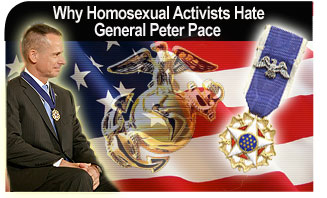
President Bush has awarded Former Chairman of the Joint Chiefs of Staff (JCS), General Peter Pace the US’s highest civilian award, the Presidential Medal of Freedom. Not surprisingly, he is once again enduring a “moral lynching” at the hands of liberal media and homosexual activists across the nation.
Controversy began plaguing General Pace, a Catholic, after his March 12 statement that homosexual acts are immoral and therefore, should not be condoned by the military.[1]
Following this statement, General Pace was maligned and ultimately lost his position as JCS Chairman, making him the first in over forty years to hold the position for only a single term. Officially, he was not nominated for a second term due to potential difficulties at his congressional confirmation hearings, because of supposed mismanagement of the Iraqi war.
Nevertheless, many believe that he lost his post because of his position against homosexual acts.
The premature ending of General Pace’s career was not enough to satisfy homosexual activists. Still inebriated from the victory over traditional marriage in California and New York, two groups spearheaded a protest against General Pace’s reception of the presidential award.
Moral High Ground
These two groups are no strangers in the struggle against morality in America. One organization called: Parents, Family and Friends of Lesbians and Gay (PFLAG), began in 1972 and today is well-known.
The other, whose stated purpose is overturning the military’s “don’t ask don’t tell” policy, is called: Servicemembers Legal Defense Network (SLDN). This organization, which has been more vocal against General Pace, issued a June 18 press release, in which SLDN Executive director, Aubrey Sarvis is quoted, saying:
Honoring General Pace with the country’s highest civilian award is outrageous, insensitive and disrespectful to the 65,000 lesbian and gay troops currently serving on active duty in the armed forces.[2]
Sarvis’ choice of words like “insensitive” and “disrespectful” demonstrate a claim to the moral high ground in the debate. This is substantiated by the images on the SLDN web site, showing different people whose countenance is carefully crafted to give the impression of indignation against unjust persecution. These images serve as page-headers for the entire site, with a different person for each section.
Each one seems to be saying: “how dare you deny me my rights.” This is especially true of the man pictured in the “Newsroom” section. Because this contention is admittedly subjective, readers are encouraged to take a look for themselves by clicking here.
This sanctimonious image is rather peculiar for a web site promoting active homosexuality in the military, a cause that not only contradicts the well-established moral depravity of homosexual acts (as was well-argued by the TFP statement: “Battling for America’s Soul,” click here), but also denies America’s soldiers their rights to safety and dignity.
Certainly, the open acceptance of homosexuals in the U.S. Armed Forces would make the close-quarter reality of military life difficult for normal soldiers. This is especially true, since battlefield conditions do not always permit high standards of modesty. Troops forced to expose themselves in the presence of homosexuals who desire amorous relations with them would be denied their basic dignity.
Furthermore, a soldier going into battle, must be prepared to be bathed in the blood of his comrades, as often happens in the heat of battle. Considering the enormous disproportion of STDs among active homosexuals, especially AIDS,[3] this would put innocent servicemen at risk of contracting behavior-related illnesses from which they would be free, otherwise. It would unnecessarily endanger their safety.
These moral issues must be considered. Thus, paraphrasing the words of Aubrey Sarvis, allowing active homosexuals to openly serve in the military is outrageous, insensitive and disrespectful to the vast majority of America’s normal troops.
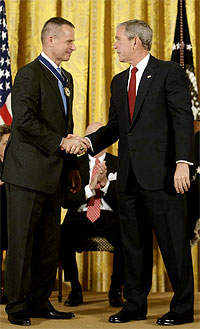
At the award ceremony, President Bush praised General Pace as a man of "complete integrity."
Peter Pace: A Man of Integrity
Clearly, the homosexual lobby lacks the integrity to admit the consequences of the aberrant sexual behavior they promote. General Peter Pace stands in stark contrast to them and is a veritable rock of scandal in their midst.
At the award ceremony, President Bush stated:
One of my great privileges as the President has been to meet so many outstanding Americans who volunteer to serve our nation in uniform. I've been inspired by their valor, selflessness, and complete integrity. I found all those qualities in abundance in General Peter Pace.[4]
This “complete integrity” is exemplified by General Pace’s reaction to the political maelstrom that followed his statement on the immorality of homosexual behavior. While the liberal media and homosexual activists cried out against him, he refused to apologize for his beliefs.
Rather, he reiterated his views in a September 2007 testimony before the Senate Judiciary Committee, saying:
We should respect those who want to serve the nation but not through the law of the land, condone activity that, in my upbringing, is counter to God’s law.[5]
Years of public service had certainly taught him the ramifications he would suffer by standing true to his convictions. Nevertheless, he remained undaunted.
Later, when he was asked to retire from his post rather than suffer the embarrassment of being denied nomination for a second term, he once again maintained his integrity. At a press conference, he explained that he refused to step down for one “fundamental reason.” No Marine or soldier should:
think — ever — that his chairman, whoever that person is, could have stayed in the battle and voluntarily walked off the battlefield. That is unacceptable as a leadership thing, in my mind.[6]
It is this fundamental integrity that has caused General Pace to be despised by the liberal media and homosexual lobby. Had he retracted or apologized, he certainly would have suffered less.
However, this integrity is also what has elevated him to hero status in the minds of Americans nationwide. It is a quality most needed for this nation in these days of relativism and compromise.
Footnotes:
 See “Is the Uproar Against General Pace the Beginning of a Religious Persecution?” http://www.tfp.org/index.php?option=com
See “Is the Uproar Against General Pace the Beginning of a Religious Persecution?” http://www.tfp.org/index.php?option=com
_content&task=view&id=477&Itemid=108. http://www.sldn.org/templates/press/record.html
http://www.sldn.org/templates/press/record.html
?section=2&record=4907. See the statements of leading AIDS researcher Dr. de Cock, as quoted at: http://www.guardian.co.uk/commentisfree/
See the statements of leading AIDS researcher Dr. de Cock, as quoted at: http://www.guardian.co.uk/commentisfree/
2008/jun/12/aids.health and Michael Fumento’s book, The Myth of Heterosexual AIDS: How a Tragedy Has Been Distorted by the Media and Partisan Politics. http://www.whitehouse.gov/news/releases/
http://www.whitehouse.gov/news/releases/
2008/06/20080619-9.html. http://www.cnsnews.com/news/viewstory.asp?
http://www.cnsnews.com/news/viewstory.asp?
Page=/Culture/archive/200806/CUL20080619b.html. http://johnib.wordpress.com/2007/06/15/
http://johnib.wordpress.com/2007/06/15/
general-pace-was-forced-out-refused-to-resign-in-wartime/.
Tuesday, June 24, 2008
781 Rosary Rally Captains so far...
Six more volunteers arrived to man the phones at our Public Square Rosary Campaign office. They have most enthusiastically dived into the phones and called many potential rally captains.
Starting from the left our new volunteers are Lay Brother De Lauro from Massachusetts, Miss Anne Anigbogu originally from Nigeria, at present from Delaware.
From northern California, Miss Ana Padilla, Mrs. Imelda Garcia, Miss Christina Huffman and finally Mrs. Mildred Bengele from Ohio.
It is wonderful to see the zeal of both young and old for the campaign. It is also so nice to see the friendships that have been formed among these children of Mary.
With their help and the help of others we have signed up 781 Rally Captains so far!
Beyond work -- America Needs Fatima volunteers learn about our Catholic history...
Over the weekend, after attending Holy Mass, Public Square Rosary Campaign Volunteers were taken on a pilgrimage to Coronado Heights, south of Salina, KS.
Tradition has it that in 1541, the Spanish conquistador, Coronado along with his army, were on that height overlooking the extensive valley below. Accompanying Coronado was a Franciscan missionary, named Father Juan Padilla. Coronado returned to Santa Fe.
Father Padilla returned to that regions of Kansas to convert the Indians. In 1542 he was martyred in that region of Kansas. He is known as the proto - martyr of the United States.
The Pilgrims prayed a rosary together at the site of a small castle built by the WPA in the 1930's in honor of Father Padilla and asked his intercession for the success of the campaign. 
After a little sight seeing in the area the volunteers were taken to a fine family style chicken dinner at the Brookville Hotel located in Abilene.
This restaurant has a Victorian theme with beautiful ceilings, wallpaper, linen table cloths and well dressed and well mannered staff.





